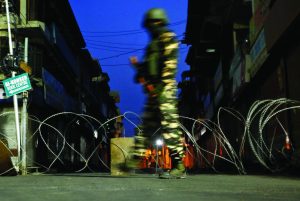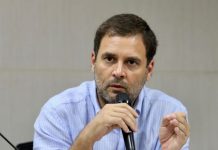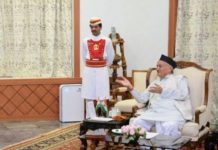 On night of November 7 when Kashmir received season’s first snowfall, little did people know that most areas of the valley will be without electricity for over a week. Entire Kashmir came under the reel of darkness for days. Even electricity in most parts of summer capital Srinagar was only restored after three days. Around 4,000-5,000 electricity poles were damaged due to snowfall.
On night of November 7 when Kashmir received season’s first snowfall, little did people know that most areas of the valley will be without electricity for over a week. Entire Kashmir came under the reel of darkness for days. Even electricity in most parts of summer capital Srinagar was only restored after three days. Around 4,000-5,000 electricity poles were damaged due to snowfall.
It was already six-days since snowfall hit Kashmir and Bashir Bhat and his family living without electricity. “We were suffering terribly in absence of electricity,” says Bashir, 55, hailing from south Kashmir’s Pulwama district.
“This showed the government’s apathy in dealing with the situation. Authorities are staying in Jammu but here in Kashmir, we are left at the mercy of God,” he claims.
Whenever Kashmir receives snowfall even by few inches, the first casualty is always the electricity where lives get disrupted and people are left with no choice to live in darkness for days.
Well, if you think the problem of errant power supply is only common during the snowfall or harsh winter then one should visit Kashmir in other seasons as well.
Sumeera Jan (18) is appearing for class 12th examinations in Kashmir. As she hails from Srinagar’s old city, Sumeera has no other alternative than to prepare for the examination in the dim light of the candles due to erratic power supply. Every year, people of old city are assured of improved power supply but the situation has worsened instead.
“My younger brother and I are not able to study properly under candle light. We don’t know when the electricity will go off. Nobody is bothered for difficulties we are facing because of abrupt power cuts,” she says, whose father is a street vendor.
“We can’t afford to purchase an inverter for lighting up all rooms of our house because of financial constraints. We have to be dependent upon candle light to take dinner and study,” Sumeera complains.
Like Sumeera, there are hundreds of students preparing for various examinations these days in Kashmir but remain affected as they are unable to study due to total power blackout.
Afreen Bano, a class 6th student and resident of Harwan area, outskirt of Srinagar, said once there is sun set her entire neighbourhood plunges into darkness.
“Our area is a metered one. We are bound to get 24×7 electricity but we get only 8-hour power supply during the day. The icy-cold water makes it difficult for us to wash our hands and face since the geysers in our home are not working due to absence of electricity,” she says.
The abrupt power cuts are making life miserable in Kashmir. Thousands of people in rurals of Kashmir still use traditional methods to light their homes and firewood for cooking meals.
Asif Ahmad, a resident of KP Road, Anantnag South Kashmir, also shares the same story. “There are at least 20 power cuts between eight hours of power supply in a day. We don’t know when the power will be turned off. The problem has further aggravated as winter has set-in,” says Ahmad.
It is an irony that Kashmir, which generates huge electricity for many Indian states, fails to supply benefit of power to its own people, Ahmad shared with an upset tonne.
J&K is having vast hydro power potential from where electricity is being supplied to several parts of India.
This is the reality that electricity generated in J&K is illuminating thousands of homes in Delhi, Punjab, Haryana and Rajasthan but new union territory is suffering from want of power.
J&K has a hydroelectricity potential of 20,000 MWs of which around 3,000 MWs have been identified so far. The National Hydro Electricity Power Corporation (NHPC) generates over 2,000 MWs from its seven power projects which is almost half of the energy, the power giant (NHPC) generates from its projects across India.
The successive governments in Jammu and Kashmir have been seeking return of at least two power projects from the NHPC.
Earlier, a Cabinet Sub-Committee (CSC) in 2011 to review the pact with NHPC on all power projects had recommended the government to buy back from the Corporation two projects — 690 MW Salal and 480 MW Uri-I — at depreciated cost of 2,566 crore.
Under the previous UPA Government, various committees like Working Group on economic development of J&K, Rangarajan Committee and Task Force on development of the State —had recommended transfer of the two power projects.
Similarly, when the PDP-BJP formed the government in 2015, it was in their ‘Agenda of Alliance’ that one power project would be returned to J&K.
Union Power Minister had said later in the Parliament that power projects cannot be transferred to J&K in view of “legal and financial problems”. Following which JK Legislative Council passed a resolution for return of power projects but nothing has been done so far in this regard.
Former J&K minister and senior Congress leader Taj Mohi-ud-Din, who fought wholeheartedly for the return of the power projects, said, “I tried my best and people also launched a campaign for return of power projects to Jammu and Kashmir but Centre rejected it.”
A senior official of the Power Development Department said J&K has to purchase electricity worth hundreds of crores annually from the Centre-owned NHPC and other power corporations.
“The J&K gets a share of just 13 per cent from the electricity that NHPC generates in new union territory,” he said.
For the last nine-years, Jammu and Kashmir government has purchased power for around 40,000 crore from various power corporations, especially the NHPC.
As per official figures, during 2011-12, 3,761.52 crore was spent on power purchases. In 2012-13, expenditure on power purchases was 4,103 crore. The power cost during 2014-15 and 2015-16 was 5,153 crore and 5,293 crore, respectively.
During 2017-18 and 2018-2019, each year over 6,000 crore was spent on power purchase.
Chief Engineer, Power Development Department, Kashmir, Hashmat Qazi admitted that valley is facing shortage of electricity. “We have availability of 1300 MWs and the demand reaches to 2200 MWs during winters. We need more electricity to overcome power shortage in Kashmir,” he said.
He, however, refused to comment over generation of electricity by NHPC. “The job of the PDD is to purchase power then supply to people. We are also facing huge revenue generation gap,” he added. Figures reveal that PDD has realised only 50 per cent power tariff for last six-years.
The government had set target 3,700 crore as power tariff during 2015-2016 but received only 1,900 crore from the consumers. In 2016-2017, department realised around Rs 1400 crore from the consumers against the target of 3,800 crore. Similarly during 2017-2018, the department realised around 2,000 against the target of 4,000 crore.
Similarly, J&K has second highest potential of solar power in India. As per the study conducted by the National Institute of Solar Energy (NISE), J&K has a solar power potential of 111.05 GWp, the second highest in India after Rajasthan, which has the potential of 142 GWp.
An official of the Power Development Department said that government is trying to explore the solar power sector in view of “huge burden” of the power purchase cost on the exchequer.
To meet the power demand and to reducing the power purchasing cost, Jammu and Kashmir Energy Development Agency (JAKEDA) has launched ‘Rooftop Solar Power Plants’ scheme.
The scheme is aimed so customers can generate the electricity on their own. Officials said under the scheme the customers who intend to generate solar energy and set up solar plants on roof-tops can get the government subsidy of 70 per cent. “The grid connect roof top solar power plants will generate electricity on own with or without battery back-up support,” officials added.
letters@tehelka.com













